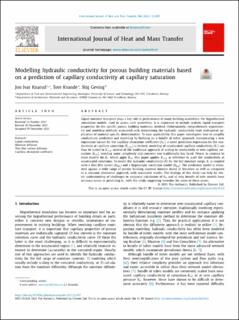| dc.contributor.author | Knarud, Jon Ivar Belghaug | |
| dc.contributor.author | Kvande, Tore | |
| dc.contributor.author | Geving, Stig | |
| dc.date.accessioned | 2022-02-11T10:50:13Z | |
| dc.date.available | 2022-02-11T10:50:13Z | |
| dc.date.created | 2021-12-31T11:19:02Z | |
| dc.date.issued | 2021 | |
| dc.identifier.citation | International Journal of Heat and Mass Transfer. 2021, 186 . | |
| dc.identifier.issn | 0017-9310 | |
| dc.identifier.uri | https://hdl.handle.net/11250/2978455 | |
| dc.description.abstract | Liquid moisture transport plays a key role in performance of many building assemblies. For hygrothermal simulation models, used to assess such assemblies, it is important to include realistic liquid transport properties for the specific porous building materials involved. Unfortunately, comprehensive experimental and modeling methods associated with determining the hydraulic conductivity limit widespread application of material-specific determination. To ease applicability, this paper investigates how to simplify conductivity prediction and modeling by building on a bundle of tubes approach. Incorporating a new expression variant for the capillary absorption coefficient (Aw), a novel prediction expression for the conductivity at capillary saturation (Kc,cap) is derived. modeling of unsaturated capillary conductivity (Kc) can thus be scaled to Kc,cap instead of the traditional approach of scaling to conductivity at over-capillary saturation (Ksat), avoiding some complexity and concerns one traditionally has faced. Hence, in contrast to most models for Kc, which apply Ksat, this paper applies Kc,cap as reference to scale the conductivity at unsaturated conditions. To model the hydraulic conductivity (K) for the full moisture range, Kc is coupled with a thin film model (Kfilm) and a hygroscopic correction model (Khyg). The prediction model is evaluated against a wide range of porous building material datasets found in literature as well as compared to a common alternative approach, with reasonable results. The findings of this study can help for better understanding of challenges in analytical calculation of Aw and of why bundle of tube models have accuracy issues in predicting Kc, with the study suggesting remedies for some of these issues. | |
| dc.language.iso | eng | |
| dc.publisher | Elsevier | |
| dc.rights | CC BY 4.0 | |
| dc.rights.uri | https://creativecommons.org/licenses/by/4.0/ | |
| dc.subject | Liquid conductivity | |
| dc.subject | Moisture diffusion | |
| dc.subject | Thin film surface diffusion | |
| dc.subject | Capillary absorption coefficient | |
| dc.title | Modelling hydraulic conductivity for porous building materials based on a prediction of capillary conductivity at capillary saturation | |
| dc.type | Peer reviewed | |
| dc.type | Journal article | |
| dc.description.version | publishedVersion | |
| dc.rights.holder | © 2021 The Authors. | |
| dc.subject.nsi | VDP::Teknologi: 500 | |
| dc.source.pagenumber | 19 | |
| dc.source.volume | 186 | |
| dc.source.journal | International Journal of Heat and Mass Transfer | |
| dc.identifier.doi | 10.1016/j.ijheatmasstransfer.2021.122457 | |
| dc.identifier.cristin | 1973129 | |
| dc.relation.project | Norges forskningsråd: 237859 | |
| dc.source.articlenumber | 122457 | |
| cristin.ispublished | true | |
| cristin.fulltext | original | |
| cristin.fulltext | original | |
| cristin.qualitycode | 1 | |

